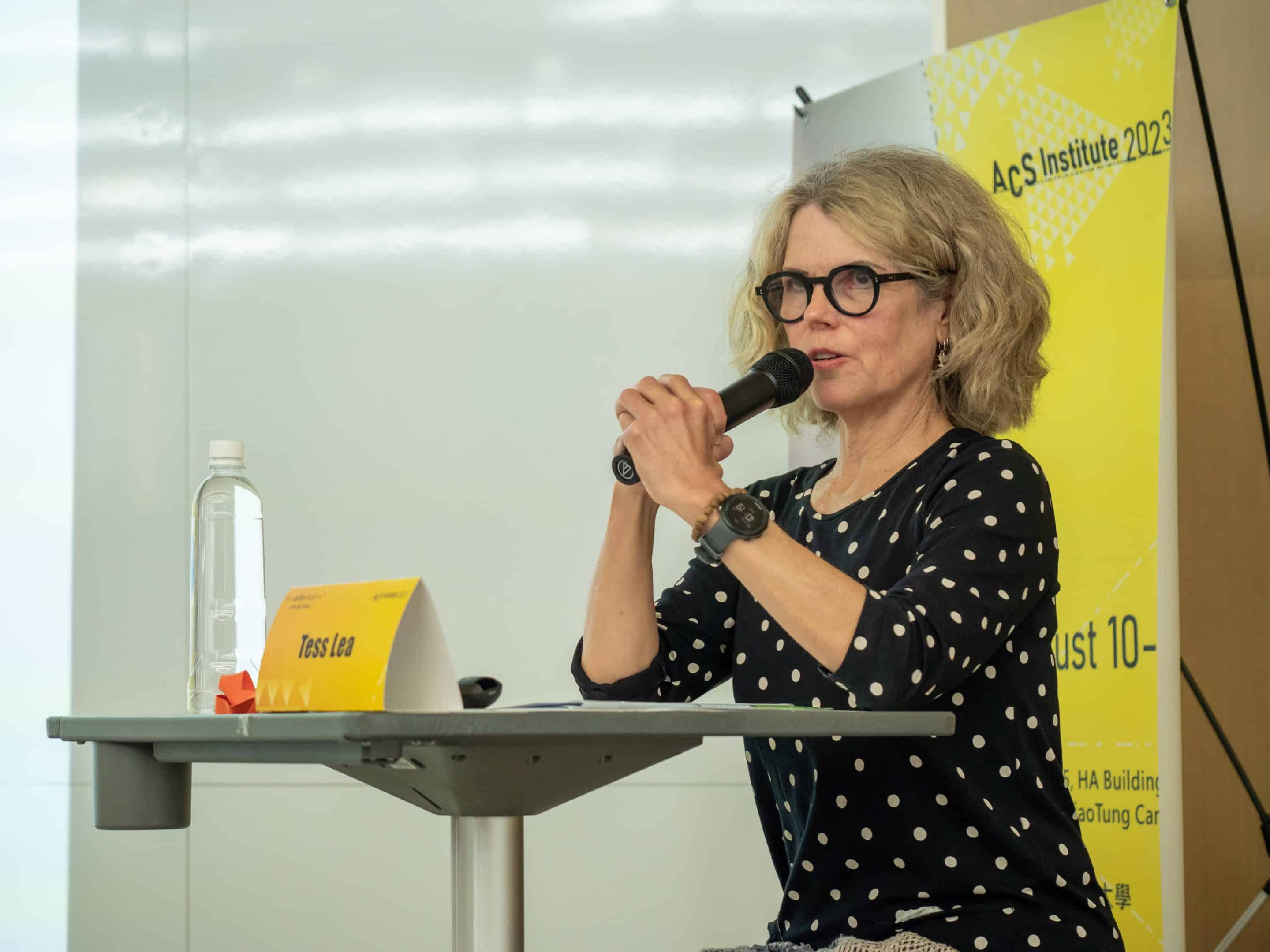
Policy Ghosts and Decolonisation in the 21st Century (keynote)
Author: GUO,QING-ROU,Institute of Social Research and Cultural Studies, NYCU
Introduction
Tess Lea is an anthropologist who specializes in the analysis of indigenous navigation, settler colonial policies and military position extraction. Her most recent book is called Wild Policy, Dignity and the Unruly Logic of Intervention.
As a white woman who only speak English from Australia, she is often humbled by people’s multilingualism, multiculcuralism, and internationalism. Her Australian origin takes her to the heart of the question of whether decolonization is actually possible for people like herself whom identify as an able-bodied white woman and her existing expectations about the indulgences that she requires to live well in this world.
Key Insights from the Lecture
After examining settler bureaucracies, policy formations and the mediation within indigenous societies across public health, schools, infrastructure, housing, mining, militarism and climate change, she acknowledges the contradiction that her ways of being in the world are increasingly impossible, untenable and unviable for planetary well being. As David Garner from the University of British Columbia argues, if decolonization is to be more than an acceptable institutional jargon, then its goal must be to bring about “the repatriation of indigenous land and life, which also means inevitably that it’s a permanently unfinished project, partly because none of us are planning to go away.”
Lea’s search is for more immediate ways to alter intolerable systems within this permanently unfinished agenda. Because not only is settler colonialism a process, so does “decolonization”. Felony colonial administrative power has the dual feature of being both omnipresent and being one of the few tools available to us to demand restitution within a bloodless paradigm.
Is decolonization even a possiblity? We have default expectations of uninterrupted functioning (OF SOCIETY?). The extractive systems that subtend our current arrangement for our life supports.
First, what and where is policy? Spending 10 years coming up with her own heuristic, she thinks of policy as simultaneous and all at once. Both artifactory, ambient and ontological.
When we talk about policy, it’s legislation, it’s statecraft, it’s black and white documents usually identifiable by very banal pros. It’s hard to read but nevertheless very consequential parts. And it’s almost always when critics come to this kind of policy, a resort to discourse analysis of one kind or another that they turn to photo. So that’s something wrong. That’s a very good thing to follow policy artefacts, but also introduces some artefacts of thinking.
Then there’s what she calls ambient policy. This is just policy sunk into our surroundings, no longer given proper name taken for granted. We are living in it right now. This is the regulatory heights and depths, air qualities and etc. If we go on to explain the permissions given to get the cement to build the stairs into a room; this is ambient policy. And that methodology that tends to invite one kind of analysis or another.
Then there is policy oncology. This is when policy is sitting inside our bodies and our minds, our psyches, our DNA, our imagination, our traumas, our hopes and our optimism. Policy is not simply as jurisprudence as political science would have it. A normative determination which journeys from conception to implementation, which we then criticize for having “unintended consequences.” A term Tess Lea abhors. Policy is material, and its heft is anything but straightforward. A very deadly policy can be subdued, so quiet that it settles into place with barely a whisper. Such as a policy which invites a foreign nation state to detonate nuclear bombs inside Australian borders on top of Australian citizens. Just a deal between Menzies and the United Kingdom without the national cabinet even being aware.
Policy resides in our bodies and our physics. In this way they can represent the very essence of coloniality. As an example, imagine a sidewalk and a road that is used by cars. Recall it as regulations of how large vehicles are allowed to be, where the liability for any trip hazards are legally accepted or refused. Consider the ageism, sexism and abolism, the class relations, the overall subordination of pedestrians and all environmental actors to motor vehicles that takes place along your stretch of road. That is 1/4 to 2/5 of all available public land. Land that once belonged to others; factory owners, farmers, indigenous people, rocks, waterways. And the policies which enabled these assorted inclusions, exclusions, lives and deaths.
The experience of indigenous Australians under continuous occupation is that of endurance in a nation. Which first cleared itself the rights to property, to land and labor. Following this with clearing the crowns access to subsurface resources. In northern territories, indigenous people have been able to get back 50% of their land ,and Tess Lea argues giving the northern territory’s land rights back is still for the best.
So overall the Australian extractive policy regime operates on a very simple rule that the fake crown owns most minerals as a priority. It was able to be so clear in it’s extraction learning from other imperial and colonial enterprises elsewhere. You can have easy policy and still note the adoption of policy of public ownership of minerals and petroleum, which sets Australia apart from other major commonwealth countries where more commonly extensive private ownership of minerals are not. How it becomes clear and easy has to do with other colonial policy tributaries.
Deolonization must be total; mind, body and extractive life supports. It is not a philosophy, it is not being materialized. Tess Lea’s collaborations with indigenous people has suggested that it’s possible to live otherwise in this world. It has also taught her to not to hold romanticism about what refusal requires and to acknowledge complicities if you perform implicitly with what indigenous people must endure and refuse to enable the brutalism and the accordance of industrial settler life worlds.
Activity for this wonderful lively world takes place on indigenous estate, current and prior, and in liberal settler communities such as Australia. Despite these dependencies, we tacitly cleave to the possibility that the benevolent state is going to confer equality on a racial eyes basis. Based on that benevolence model some critique the relationship between decolonization, indigenity and climate change. It can be naively proposed that all we need to do is listen to the indigenous people and endeavour to have good relations with them.
Tess Lea proposes that there is a connection between indigenous circumstance, colonial occupation, unsustainable population growth worldwide and climate change. Though for methodology and conceptional reasons it’s hard to make. To re-see these connections she had to devise a policy heuristic, distinguishing the three primary figures of policy artefacts, policy ambiance and policy ontology.
Indigenous social policies primary function is to subtend extractive capitalism. To offer their colonial benefits, indigineous social policy has to unwind extractive capitalism and the giant shakedown system that is the financial session of everyday life. The challenge is how might such heterogenous of past, present and future be harnessed for decline of your work. We must transcend the barely checked ability of extraction for them to drill, spill, contaminate and induce our infrastructural dependencies.
Many reasons for failure have been suggested such as insufficient consolation; going top down rather than bottom up. Tactical or impedimentary errors, insufficient time or weak political will or contradictions between national, state, territory or multinational interests. Other reasons include inadequate capacity building within communities, neglect of place-based approaches, weak governance, corruption or unintended consequences.
Conclusion:
When we acknowledge the connections, extractivism and colonial existence becomes vicious. Tess Lea suggests every act of decolonization is necessary and every act is insufficient. The question begs to ask, is removing dependency on indigenous colonialism from global bodies even a possibility?

Related Articles
Related
Field notes of the port trip in Taiwan
Reported by Aubrey Fanani, Chang Wen-Chi, Jonathan Parhusip, and Qi Li Following the 2023 ACS Institute “De-colonization in the 21st Century”, the International Center for Cultural Studies (ICCS) organized a four-day excursion to southern Taiwan to investigate the...
PRESENTING XR: REENACTING REALITY, RECONNECTING SOCIETY
Reported by Aubrey Kandelila Fanani, MA Student, IACS-NYCUIntroductionXR (extended reality), a term to refer to Virtual reality (VR), Augmented Reality (AR), and mixed reality (MR), has attracted artists to engage with it, not only game developers but also filmmakers,...
DOCUMENTA 15: A DISAGREEMENT
Reported by Aubrey Kandelila Fanani, MA Student, IACS-NYCUIntroductionBeginning in 1955, Documenta, which took place in Kassel, Germany, became one of the most prestigious contemporary art exhibitions. The last Documenta 15 started on June 18 and ended on September...

0 Comments